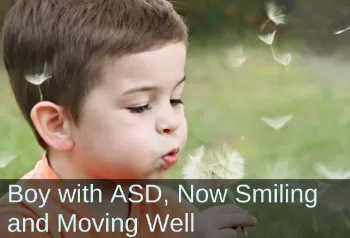Primitive Reflex Integration Case Studies
5-Year-Old with Autism: Was Crying and Screaming with Challenges, Now Eager to Try New Skills
Rhythmic movements and reflex integration help with ADLs, emotional regulation, motor skills, and more
This preschooler struggled with ADLs such as removing his socks, was easily upset, and could not sit cross-legged. By providing rhythmic movements and integrating his reflexes, his OT greatly improved his gross motor function and emotional regulation.
Submitted by Andrea Ladowski MS OTR/L

| Before | After |
|---|---|
| Could not cross his legs to sit in a Taylor sitting position (criss-cross) | Can now sit at circle time with legs crossed |
| Could not bend over to take off his socks or shoes | Can now take off his socks using both hands and bending legs |
| Fearful of swinging on swings (gravitational insecurity) | Now able to gently swing on a Lycra swing |
| Would become overly upset, crying and screaming, when minimally challenged | Eager to try new skills |
| Did not know how to crawl | Has now progressed to reciprocal crawling |
Alex is a 5 year-old student with the diagnosis of Autism. Although he is non-verbal, he can understand verbal instructions and imitate simple movement patterns. His main areas of concerns are his stiff movements of his trunk and lower extremities. For example, during circle time Alex could not cross his legs to sit in a Taylor sitting (criss-cross). Alex could not bend over to take off his socks or shoes. His movements were extremely limited and he was fearful of swinging on swings (gravitational insecurity)
When he was minimally challenged, he would become overly upset by crying and screaming.
My Goal: Alex would be able to take off/put on his socks.
Dates of treatment: 12/11/2020, 12/18/2020, 1/8/2020, 1/15/2020, 1/22/2020, 1/29/2020-each session was 30 minutes)
During Alex’s weekly OT sessions, I started working on the Rhythmic movements [from the Brain and Sensory Foundations course] to improve his body awareness, trunk rotation, and try to move his body in a flexed position.
My observations during the first 2 sessions were amazing. Alex was able to sit in a Lycra swing with his knees bent to his chest. He smiled as I swung him slowly back/forth. He even allowed me to slowly half spin the swing. Since I noticed significant progress within the first 2 sessions, I instructed his Aide and his parents on the Rhythmic movements to complete on a daily basis.
Role Play: At the beginning of each session, Alex would watch me take off one of his socks. He had to work on taking on the other sock. He needed a lot of assistance with positioning his knee bent and crossed over the other leg.
During the next 3 sessions, Alex started with Rhythmic movements and transitioned to working on TLR [Tonic Labyrinthine Reflex] activities. He needed a lot of demonstration to understand movements. His Aide helped with facilitating the movements during OT sessions. He worked on ATNR [Asymmetrical Tonic Neck Reflex] through resistive crawling through a fabric tunnel. At first, Alex would scoot on the floor as he did not know how to crawl. He progressed to reciprocal crawling and pushing a ball through the tunnel. We tried to work on Moro Reflex, but Alex had a difficult time imitating the movement patterns.
With weekly repetition, Alex was improving his ability to take off his socks using both hands and bending his legs. When he found success with taking off his socks, I video taped him. Alex would watch the video during the week to reinforce his success.
My observations of his progress continued to surprise me. Alex could sit at circle time with his legs crossed. He non-verbally requested to spin in the lycra swing. As he spun, he made eye contact with therapist, smiled, and started initiating sounds to spin more.
Goal Achieved
For his self-help skills, before I started using these treatment strategies [from the Brain and Sensory Foundations course], Alex used his feet to try to take off his socks because he could not bend over and reach his feet with his hands. After approximately six sessions, Alex was able to bend his legs and independently take off his socks. He initiated putting on his socks and could independently put on 1 out of 2 socks.
Lessons Learned: Alex was my first student that I tried these techniques with since starting the course. I learned how important the rhythmic movement patterns were to help Alex relax his body, move, and position himself in more functional ways at school. With the repetition, Alex was eager to start sessions, and try new skills. Emotionally, he did not become upset when he was challenged.
[Edited for length and clarity, emphasis added]
*Disclaimer: The activities in the Brain and Sensory Foundations curriculum make use of the natural processes of neuroplasticity and development that are innately wired in the design of human beings to promote maturity and function. These activities appear to calm, organize, and mature the neuro-sensory-motor systems just as we see in the healthy development of human infants. Individual results may vary, and we do not claim to offer a diagnosis or cure for any specific condition or disorder. The Brain and Sensory Foundations activities appear to improve overall functioning resulting in measurable improvements for a range of conditions as demonstrated in over 1800 case studies from participants.

